Shure orporated UT1D Belt Worn Wireless Microphone User Manual 27a8692
Shure Incorporated Belt Worn Wireless Microphone 27a8692
Manual


ENGLISH
THE TWO MINUTE USER’S GUIDE
2:00
The instructions on this page will help you get your UT Series system up and
running in minutes. For more detailed instructions, read the section of this
manual that applies to your system.
RECEIVER SETUP
1. Connect the supplied ac power adapter to the DC INPUT connector on the back of
the receiver. Insert the adapter’s cable into the power cable retainer on the bottom
of the unit. Plug the adapter into a wall socket or other electrical outlet. The green
POWER light on the receiver will glow.
2. If you are using The Guitarist-UHF, connect the receiver output to a guitar am-
plifier using any standard guitar cable. If you are using The Vocal Artist-UHF,
The Headset-UHF, or The Presenter-UHF, connect the receiver output to an
audio mixer using an XLR to XLR audio cable.
3. Raise the antennas and point away from each other at a 45° angle from vertical.
TRANSMITTER SETUP
1. Open the transmitter battery compartment and install a 9 V battery. Observe proper
battery polarity (“+/–”).
2. If you are using The Vocal Artist-UHF, no further transmitter setup is required.
3. If you are using a body-pack transmitter (The Presenter-UHF, The Headset-UHF
or The Guitarist-UHF), plug the microphone cable or a WA302 instrument cable
into the four-pin connector on the transmitter (if using The Headset-UHF, see tag
on headset for assembly instructions). If using The Guitarist-UHF, plug the instru-
ment cable into the guitar output and adjust the volume control of the guitar.
OPERATING THE SYSTEM
1. Slide the transmitter POWER/OFF switch to the POWER position. The transmitter’s
green POWER light and the receiver’s yellow DIVERSITY A/B lights will glow.
2. Slide the MUTE/ON switch on the body-pack or hand-held transmitter to the ON
position.
3. Talk or sing into the microphone, or play your guitar. The receiver’s red AUDIO PEAK
light should flicker when loud sounds are transmitted. If the AUDIO PEAK light does
not flicker or stays on constantly, the transmitter gain may need adjustment. (Refer
to the
Transmitter Audio Gain Adjustment
section). NOTE: This step is particularly
important for The Guitarist system, since guitar outputs can vary widely.
4. Adjust the receiver VOLUME control until the receiver output level matches the
level of your guitar or microphone through a cable. (The factory setting is in the
full clockwise position.) If using The Guitarist-UHF system, see
Receiver Volume
Adjustment for The Guitarist-UHF
to match the receiver volume level to the level
of a wired system.
YOU ARE NOW READY TO PERFORM!
IMPORTANT:
Every
wireless performance is a unique situation, and can present a vari-
ety of problems.
Never
attempt a performance without first conducting a “walkthrough”
test on the wireless system in the performing area.
If you encounter a problem, refer to
the Troubleshooting table.
2

ENGLISH
THANK YOU FOR CHOOSING SHURE
Congratulations!
You have purchased the finest wireless system in its
class. Your Shure wireless system is engineered to provide a low-noise,
high-quality sound comparable to other systems costing much more. Built
in the tradition of reliability that has made Shure a symbol of American quali-
ty for more than half a century, this wireless system should provide you with
excellent performance for years.
To get the most out of your UT Series wireless system, please read the
applicable section in this guide before you attempt to use the system. If you
have any questions that are not answered in this booklet, please contact
Shure Customer Service at (847) 866-2553, Monday through Friday, from
8:00 am to 4:30 pm, Central Standard Time. For technical data by fax, dial
(800)488-3297 and follow the recorded instructions. Visit our website at
www.shure.com for further information on this and other Shure products.
INTRODUCTION
Your new UT Series system is designed to give you the best of both sound reinforce-
ment worlds: the freedom of a wireless system, and the reliability of world-famous
Shure sound quality. This manual covers each of the UT Series systems: The Vocal
Artist-UHF, The Presenter-UHF, The Headset-UHF, and The Guitarist-UHF.
SYSTEM FEATURES
All Shure UT Series systems offer a variety of of exceptional features, including:
•Diversity Receivers with Exclusive Shure MARCAD Circuitry: MARCAD
(MAximum Ratio Combining Audio Diversity) circuitry continuously processes
the rf signal from each antenna and combines the audio outputs to produce one
signal of optimum quality. The result is improved reception and exceptional free-
dom from dropouts.
•Low-Traffic UHF Transmission: UT systems use a UHF (Ultra High Frequen-
cy) range between approximately 596 to 862 MHz (available frequencies de-
pend on regulations in the country where the system is used). In urban areas,
UHF frequencies are less congested than those in the VHF range, and are less
susceptible to interference.
•Multiple System Use: Up to eight UT systems can be used in the same perfor-
mance space. Each system must be set at a different frequency. If systems are
set to the same frequency, contact an authorized Shure dealer. NOTE: In multi-
ple use situations, each transmitter must have a dedicated receiver.
•Simultaneous Output Use: Unbalanced 1/4” phone plug and balanced XLR
output connectors may be used simultaneously to different external devices.
•Stackable and Rack-Mountable Receivers: If multiple systems are in use, re-
ceivers may either be stacked or rack-mounted, with two receivers fitting in the
optional rack mount tray. In these situations, antennas should not touch or be
crossed. (See
Stacking and Rack-mounting Receivers
.)
•Range: UT Series transmitters will work at a distance of up to 100 meters (about
300 ft.) from the receiver.
•Noise Squelch: The noise squelch circuit analyzes signal quality instead of sig-
nal strength, which allows the circuit to discriminate between noise and desired
signal. This reduces the likelihood of noise burst due to environmental rf (radio
frequency) noise.
•Semi-Rigid Receiver Antennas: Three-inch rubberized antennas offer perfor-
mance equal to telescoping antennas with added durability.
•Low Battery Warning Light: A red light on the body-pack and hand-held trans-
mitters warns the user that there is less than one hour of battery life left.
3

ENGLISH
SYSTEM TYPES
The Vocal Artist-UHF
is a hand-held system designed for singers who desire the
high quality of Shure microphones and the freedom of wireless performance. In-
cludes a Shure BG3.1 or SM58 dynamic microphone with a built-in transmitter.
The Presenter-UHF
is a body-pack system designed for public speakers who prefer
an inconspicuous, hands-free lavalier microphone. Features an omnidirectional
Shure WL93, supercardioid WL184, or cardioid WL185 micro-miniature lavalier mi-
crophone.
The Headset-UHF
is a body-pack system designed for users in physically active ap-
plications, who desire the freedom of hands-free microphone operation along with the
performance of Shure wireless equipment. Features a WH20TQG headset microphone.
The Guitarist-UHF
is a body-pack system designed for use with electric guitars,
basses, and other electric instruments. May be used with brass or woodwind instru-
ments, with optional WM98 instrument microphone and mount. The Guitarist pro-
vides the freedom of going wireless and the reliability of high quality Shure sound.
SYSTEM COMPONENTS
Component
The Vocal Artist-UHF The Presenter-UHF The Headset-UHF The Guitarist-UHF
Transmitter UT2 Hand-Held Micro-
phone Transmitter
UT1 Body-Pack Transmitter
Microphone* BG 3.1 or SM58
Hand-Held Micro-
phone
WL93, WL184 or
WL185 Lavalier
Microphone
WH20TQG Headset
Microphone —
Receiver UT4 Diversity Receiver with MARCAD Circuitry
Power Supply PS20 (120 Vac, 60 Hz) or PS20E (230 Vac, 50 Hz)
Supplied
Accessories
Microphone Stand
Adapter, Vinyl Trans-
mitter Bag,
Receiver Feet,
Receiver VELCRO
Mounting Strips
Vinyl Transmitter Bag,
Receiver Feet,
Receiver VELCRO
Mounting Strips
Vinyl Transmitter Bag,
Receiver Feet,
Receiver VELCRO
Mounting Strips
Vinyl Transmitter Bag,
Receiver Feet,
Receiver VELCRO
Mounting Strips
*Additional microphones may be available at later date
STACKING AND RACK-MOUNTING RECEIVERS
SHURE
SHURE
STACKED RECEIVERS
SHURE SHURE
RACK-MOUNTED RECEIVERS
FIGURE 1
The UT4 receiver may be used in numerous applications, and is designed to be easi-
ly stacked or rack-mounted for multiple system use (see Figure 1).
•
To stack receivers
: The raised corners are designed to create stability when receiv-
ers are stacked, if placed on a flat surface with feet attached. It is important to posi-
tion the antennas at a 45° angle from vertical so that the antennas do not touch.
•
To rack-mount receivers
: The UT4 receiver is a half-rack unit, and two receivers
should fit into a standard rack space. Place the outer antennas at a 45°angle from
vertical; place the inner antennas in a vertical position. ANTENNAS SHOULD NOT
CROSS OR TOUCH. (See Optional Accessories for rack mount accessories.)
4
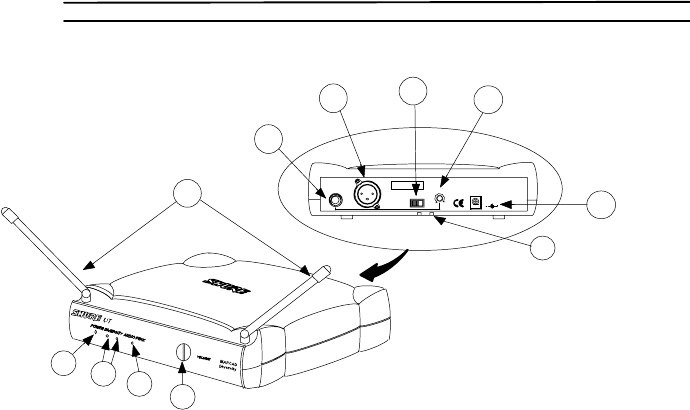
ENGLISH
6
7
10
9
11
1234
5
8
SHURE BOTHERS INC.
EVANSTON IL 60202 USA
UT4 DIVERSTIY RECEIVER
12–18 VDC
DC INPUT
UNBALANCED
HIGH Z
BALANCED
LOW Z
LINE MIC
SQUELCH
MIN MAX
FIGURE 2
.
.
...
.
..
.
..
UT4 DIVERSITY RECEIVER FEATURES (FIGURE 2)
1. Power On Indicator: This green light glows when the receiver is plugged into an
electrical outlet. It indicates that the receiver is on.
2. Diversity Signal Indicators: The yellow DIVERSITY A/B lights glow when rf (radio
frequency) signals are received from the UT1 or UT2 transmitter. When only one light
is glowing, the signal is being received on only one antenna. When both lights are
glowing, the UT4 is receiving signals on both antennas.
3. Audio Peak Indicator: This red light flickers when the receiver input signal ap-
proaches the overload clipping level. It is affected by the transmitter gain control set-
ting, and the level of the guitar or bass (
The Guitarist-UHF
systems) or the singer or
the speaker (
The Vocal Artist-UHF, The Presenter-UHF,
and
The Headset-UHF
sys-
tems).
4. Volume Control: Rotate this knob to increase or decrease the volume of the re-
ceiver output. This control does not affect the AUDIO PEAK indicator.
5. Semi-Rigid Receiver Antennas: The semi-rigid receiver antennas should be
pointed away from each other at 45° angle from vertical for best performance, and
should not touch when stacked or rack-mounted.
6. 1/4” Phone Jack Audio Output Connector (Unbalanced High Z): An unbalanced
audio cable with a 1/4” phone plug (such as a standard guitar cable) can be used
between this connector and your amplifier input.
7. XLR Audio Output Connector (Balanced Low Z): Plug an XLR audio cable
from this connector to the input of your mixer.
8. Mic/Line Slide Switch: Switches output of XLR connector from microphone to
line level. Use of line level is suggested when connecting receiver to a mixing or
amplifying device without an available mic-level input, such as a power amplifier,
signal processing device or VCR.
9. Squelch Control: Adjusts squelch control setting to emphasize either signal quality
or system range. This control is factory pre-set, and normally does not need further
adjustment. Refer to
Receiver Squelch Adjustment
section for more information.
10.Power Input Connector: Connect the ac adapter to this jack and then plug into
an ac electrical outlet.
11. Power Cable Retainer: Secures the ac adapter cable to receiver.
5
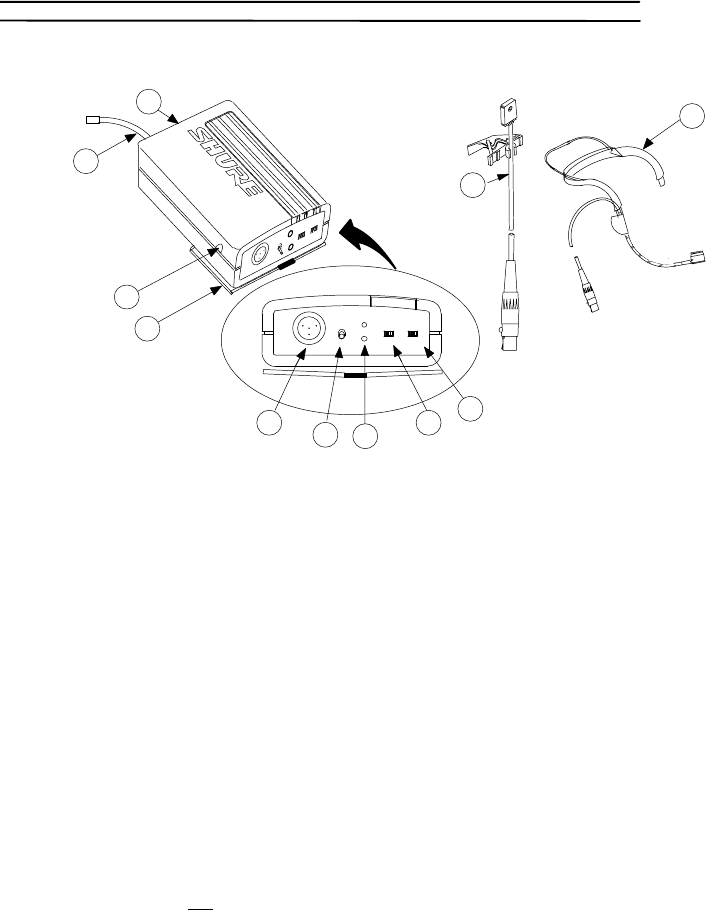
ENGLISH
FIGURE 3
11
10
ON
MUTE
LOW BATT
OFF PWR
1
2
3
4
5
6
7
8
9
INPUT
ATTEN
0-20
UT1 BODY-PACK TRANSMITTER FEATURES (FIGURE 3)
1. Power/Off Switch: Turns transmitter power on and off.
2. Input Attenuation Switch: Allows choice between 0 dB and –20 dB attenuation,
for greater range of audio gain control.
3. Power/Battery Fuel Gauge: The green light indicates the unit is on. The red light
indicates less than one hour of battery life remains.
4. On/Mute Switch: Mutes the transmitter to prevent unwanted sounds from being
picked up by the receiver
without
turning the transmitter off.
5. Input Connector:Tini Q-G connector allows connection to a variety of lavalier and
headset microphone cables and the Shure WA302 instrument adapter cable.
6. Belt Clip: Secures the transmitter to a belt, waistband or guitar strap.
7. Audio Gain Control: Provides audio level adjustment to accommodate various input
signal strengths (e.g., speaking into a microphone or playing an instrument). The fac-
tory setting is at mid-point. A small screwdriver is supplied to make adjustments.
8. Antenna: A flexible wire antenna is permanently attached to the bottom of the
UT1 body-pack transmitter.
For best operation, the antenna must hang vertically,
and should not be coiled or bundled.
9. Battery Compartment: Holds one 9 V battery. Hinged cover opens to provide ac-
cess to the battery.
10. Lavalier Microphone (WL93 shown): Omnidirectional (WL93), supercardioid
(WL184) or cardioid (WL185) condenser lavalier microphone, featuring a mount
that clips onto a tie, lapel, or acoustic instrument and an attached TQG connector
(supplied with The Presenter system)
11. Headset Microphone (WH20TQG shown): Headset microphone features a
headset frame, headband, and an attached TQG connector. See tag attached to
headset for assembly instructions (supplied with The Headset System).
6
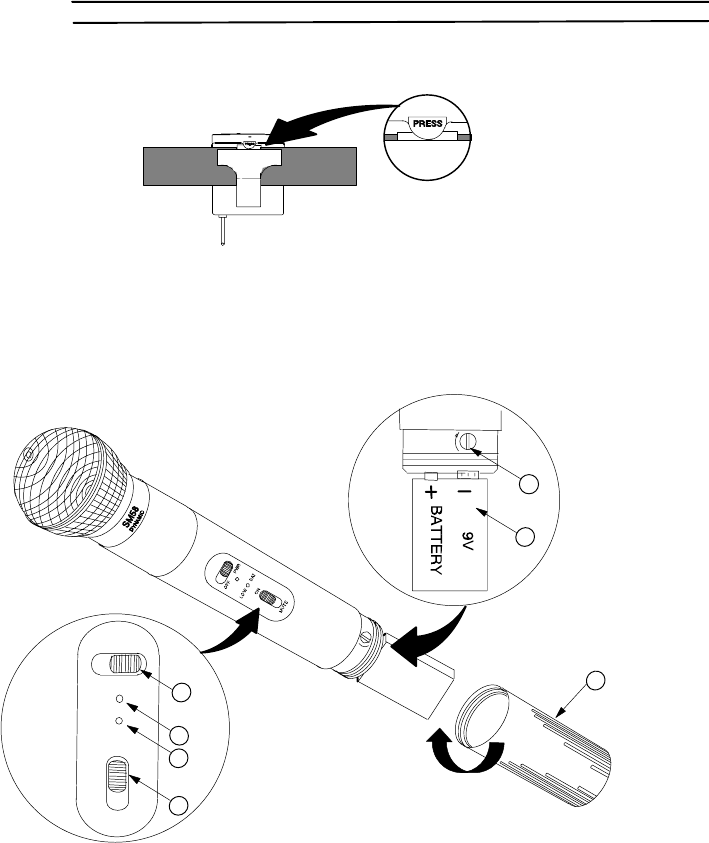
ENGLISH
ATTACHING THE UT1 BODY-PACK TRANSMITTER TO BELT OR
GUITAR STRAP
FIGURE 4
1. Depress the tab marked PRESS and slip your belt, waist band or guitar strap be-
tween the transmitter body and the belt clip (Figure 4).
2. The clip holds tighter if the material is drawn to the clip’s top wire, especially when
using thinner guitar straps.
UT2 MICROPHONE-TRANSMITTER FEATURES (FIGURE 5)
4
17
6
5
FIGURE 5
2
3
FF
OPWR
LOW BAT
ON
MUTE
1. Power/Off Switch: Turns the transmitter on and off. It is recessed to prevent it
from being accidentally turned off.
2. Power On Indicator: Green light glows when the POWER/OFF switch is in the
POWER position, as a reminder to turn the transmitter off when it is not in use.
3. Low Battery Indicator: A red light glows when there is one hour or less of useful
operating time, allowing battery to be changed before power is depleted.
4. On/Mute Switch: Allows muting of the microphone audio, avoiding the “thump”
noise that can occur when turning the transmitter on and off.
5. Audio Gain Control: Allows the level of vocals to be matched with the transmit-
ter for better performance.
6. 9 V Battery (shown installed): Provides power to the microphone-transmitter.
7. Battery Cover: Unscrews for access to the 9 V battery and gain control.
7
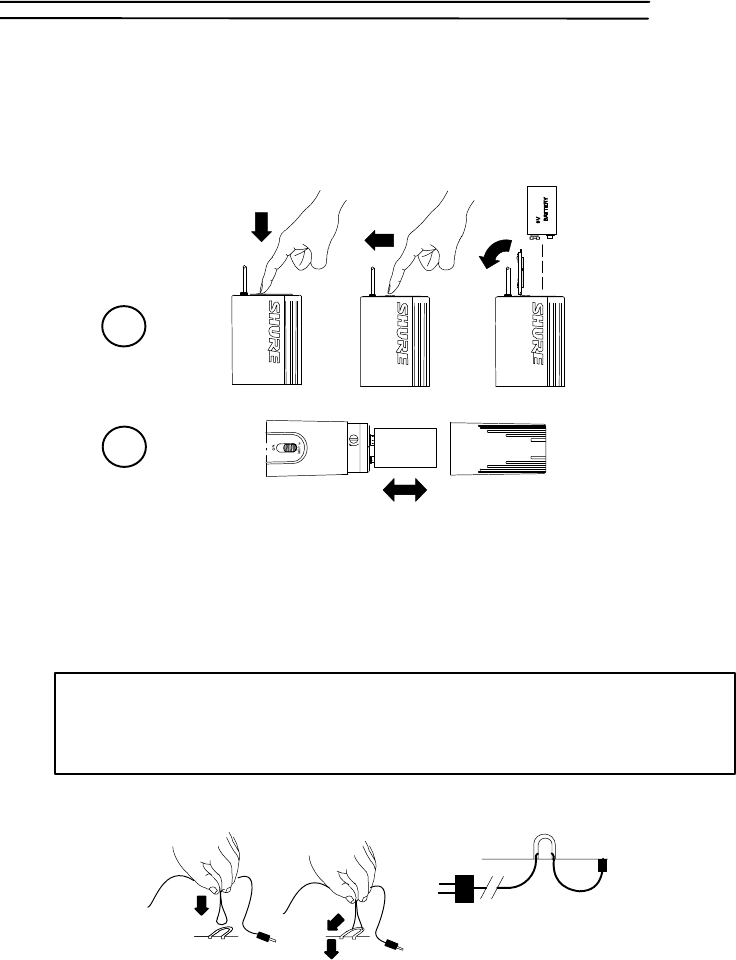
ENGLISH
TRANSMITTER BATTERY INSTALLATION
1. Slide the transmitter POWER/OFF switch to the OFF position.
2.
Body-Pack
: Press down on the OPEN side of the battery compartment cover,
slide it back and flip it open, as shown in Figure 6A.
3.
Hand-Held:
Unscrew the transmitter battery cover to expose the battery termi-
nals, as shown in Figure 6B.
+
-
FIGURE 6
A
B
-
+
4. Insert a fresh 9 V battery into the battery compartment as shown in Figure 6.
5. Replace battery cover.
6. When the transmitter’s red LOW BATTERY light glows, you have 1 hour or less
of useful battery life remaining; change the battery at your first opportunity.
IMPORTANT: 9 V Alkaline batteries are recommended. 9 V lithium batteries are op-
tional. Carbon-zinc and zinc-chloride batteries will not provide adequate power and
are not recommended. 8.4 V rechargeable NiCd batteries may be used, but are not
recommended due to minimal lifespan. See
Battery Life
in Specifications for further
details on battery selection.
INSTALLING AC ADAPTOR CORD INTO POWER CABLE RETAINER
POWER CABLE RETAINER
(BOTTOM VIEW)
AC POWER ADAPTER AND
ABC
FIGURE 7
1. Refer to Figure 7. Turn the receiver over and locate the power cable retainer. Pinch
the ac adaptor cord approximately 6 inches from the dc plug, forming a small loop
(A). Hold the cord vertical to the retainer and lower the tip of loop into the curved por-
tion of retainer.
2. Keeping the cord vertical to the receiver, pull the cord under the tab towards front
of the receiver (B), then pull down, locking the cord into the retainer (C).
8
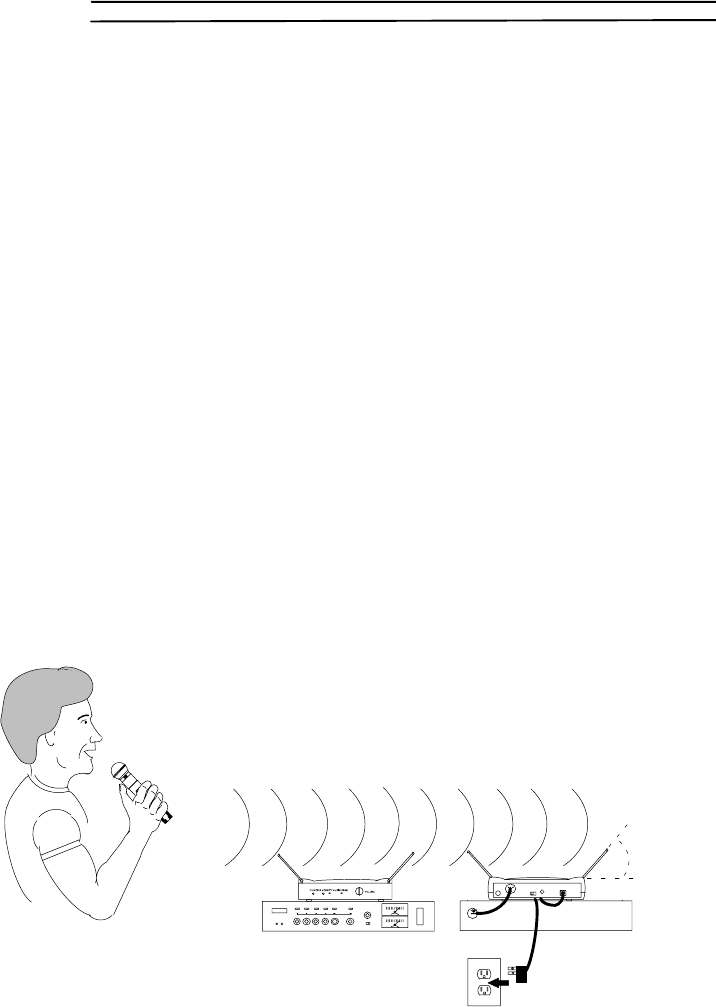
ENGLISH
OPERATING THE VOCAL ARTIST-UHF SYSTEM
1. Refer to Figure 8. Connect the supplied ac power adapter into the DC INPUT con-
nector in back of the receiver. Insert the adapter’s cable into the power cable retainer.
Plug the adapter into a wall socket or other ac power source (use PS20 for 120 Vac,
60 Hz power; use PS20E for 230 Vac, 50 Hz power). The green POWER light on
the receiver will glow.
2. Connect the receiver’s XLR AUDIO OUTPUT connector to the mixer input using an
XLR to XLR audio cable. If no XLR cable is available, a 1/4” to 1/4” phone plug cable
may be substituted, but this connection will not be balanced. Set the receiver’s MIC/
LINE SWITCH to match the sound system’s input.
3. Slide the transmitter’s POWER/OFF switch to the POWER position. The transmit-
ter’s green POWER ON light and the receiver’s DIVERSITY A/B lights will glow.
4. Slide the microphone’s ON/MUTE switch to the ON position to turn the micro-
phone on.
5. Talk or sing into the microphone. Normal operation is indicated by:
•
Steady glow of the receiver’s yellow DIVERSITY A/B lights.
•
Flickering of the receiver’s AUDIO PEAK light when loud sounds are transmitted.
NOTE: If the receiver’s red AUDIO PEAK light does not flicker occasionally or is
constantly on, the transmitter gain may need to be adjusted. Refer to the
Trans-
mitter Audio Gain Adjustment
section. Then, If the system is still not operating
properly, consult the
Troubleshooting
table.
6. When the performance is over, turn off the sound system and slide the transmit-
ter’s POWER/OFF switch to the OFF position to conserve battery power.
FIGURE 8
UT2
SHURE
UT4
45°
FRONT BACK
9
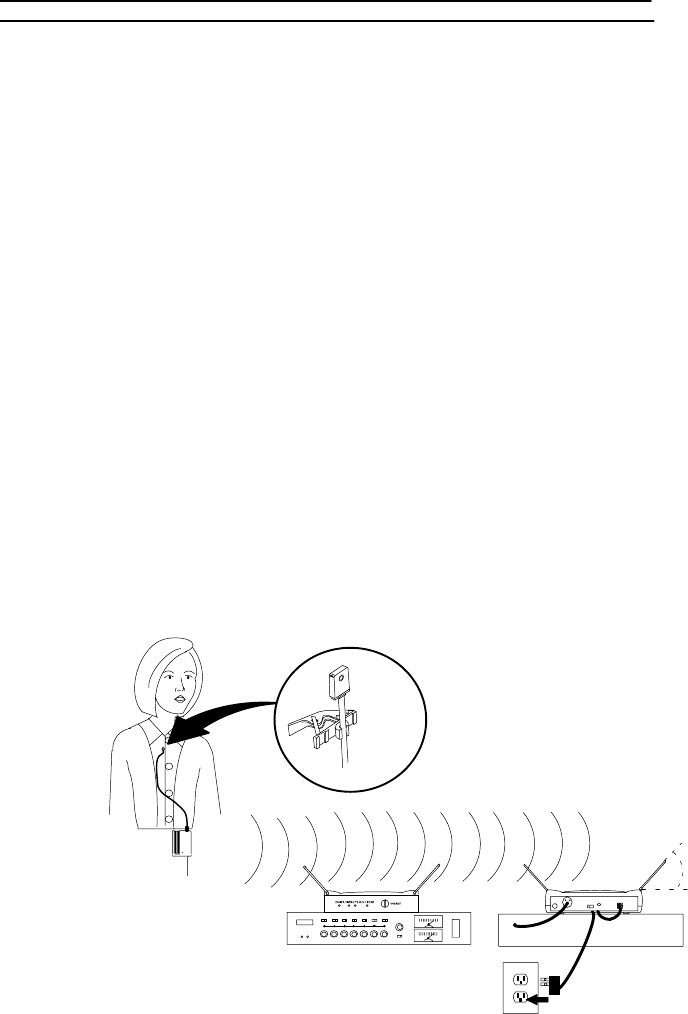
ENGLISH
OPERATING THE PRESENTER-UHF SYSTEM
1. Refer to Figure 9. Connect the supplied ac power adapter to the DC INPUT con-
nector on the back of the receiver. Insert the adapter’s cable into the power cable
retainer. Plug the adapter into a wall socket or other ac power source (use PS20
for 120 Vac, 60 Hz power; use PS20E for 230 Vac, 50 Hz power). The green
POWER light on the receiver will glow.
2. Connect the receiver’s XLR AUDIO OUT connector to the mixer input using an XLR
to XLR audio cable. If no XLR cable is available, a 1/4” to 1/4” phone plug cable may
be substituted, but this connection will not be balanced. Set the receiver’s MIC/LINE
SWITCH to match the sound system’s input.
3. Press the WL93, WL184 or WL185 lavalier microphone into the mounting clip and
attach it to your garment. Do not cover the microphone with your clothing, and
keep it approximately 8 to12 inches below your chin. See Figure 9.
4. Slide the recessed transmitter POWER/OFF switch to the POWER position. The
transmitter’s green POWER ON light and the receiver’s yellow DIVERSITY A/B
lights will glow.
5. Slide the transmitter’s MUTE/ON switch to the ON position.
6. Speak in your normal conversational voice. Proper operation is indicated by:
•
Steady glow of the receiver’s yellow DIVERSITY A/B lights.
•
Flickering of the receiver’s AUDIO PEAK light when you speak in a loud voice.
NOTE: If the receiver’s red AUDIO PEAK light does not flicker occasionally or is
constantly on, the transmitter gain may need to be adjusted. Refer to the
Trans-
mitter Audio Gain Adjustment
section. If the system is still not operating properly,
consult the
Troubleshooting
table.
7. When the presentation is over, turn off the sound system and slide the recessed
transmitter POWER/OFF switch to the OFF position to conserve battery power.
FIGURE 9
WL93
SHURE
SHURE
45°
UT1
UT4
FRONT BACK
shown
10
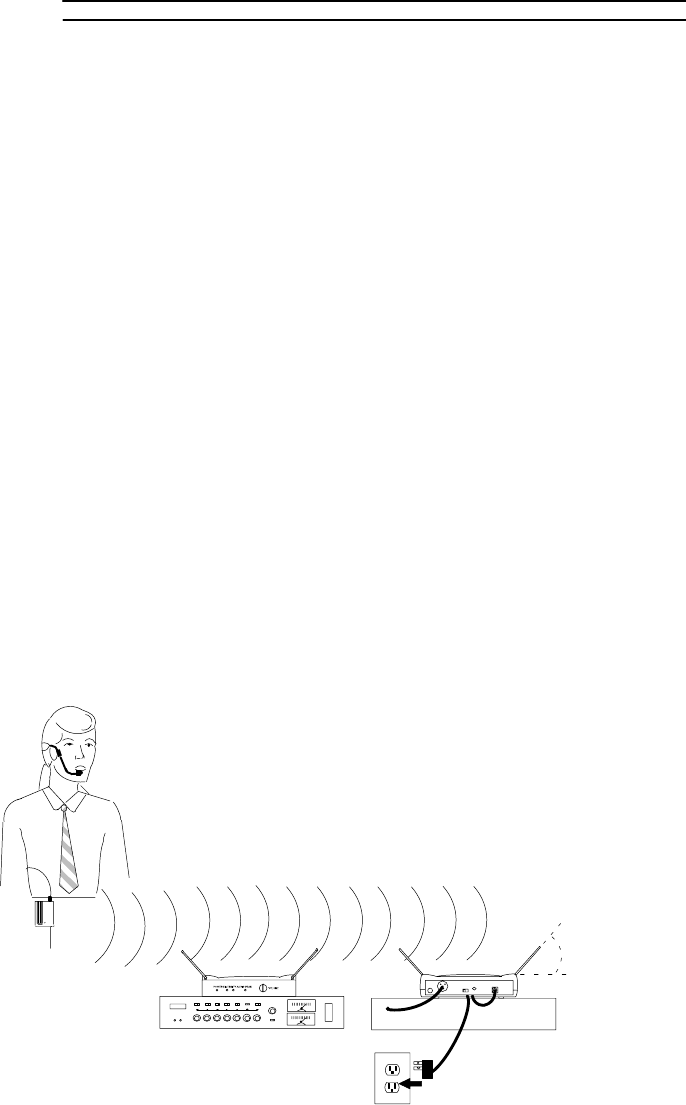
ENGLISH
OPERATING THE HEADSET-UHF SYSTEM
1. Refer to Figure 10. Connect the supplied ac power adapter to the DC INPUT con-
nector on the back of the receiver. Insert the adapter’s cable into the power cable
retainer. Plug the adapter into a wall socket or other ac power source (use PS20
for 120 Vac, 60 Hz power; use PS20E for 230 Vac, 50 Hz power). The green
POWER light on the receiver will glow.
2. Connect the receiver’s XLR AUDIO OUT connector to the mixer input using an XLR
to XLR audio cable. If no XLR cable is available, a 1/4” to 1/4” phone plug cable may
be substituted, but this connection will not be balanced. Set the receiver’s MIC/LINE
SWITCH to match the sound system’s input.
3. If using the headset for the first time, refer to the tag attached to the headset for
assembly instructions. Adjust headband and place on head, as shown on tag. For
best results, microphone should be placed 1/2” from side of mouth.
4. Slide the recessed transmitter’s POWER/OFF switch to the POWER position.
The transmitter’s green POWER ON light and the receiver’s yellow DIVERSITY
A/B lights will glow.
5. Slide the transmitter’s MUTE/ON switch to the ON position.
6. Speak in your normal conversational voice. Proper operation is indicated by:
•
Steady glow of the receiver’s yellow DIVERSITY A/B lights.
•
Flickering of the receiver’s AUDIO PEAK light when you speak in a loud voice.
NOTE: If the receiver’s red AUDIO PEAK light does not flicker occasionally or is
constantly on, the transmitter gain may need to be adjusted. Refer to the
Trans-
mitter Audio Gain Adjustment
section. If the system is still not operating properly,
consult the
Troubleshooting
table.
7. When headset is not in use, turn off sound system and slide the recessed trans-
mitter POWER/OFF switch to the OFF position to conserve battery power.
FIGURE 10
SHURE
SHURE
UT1
UT4
45°
FRONT BACK
11
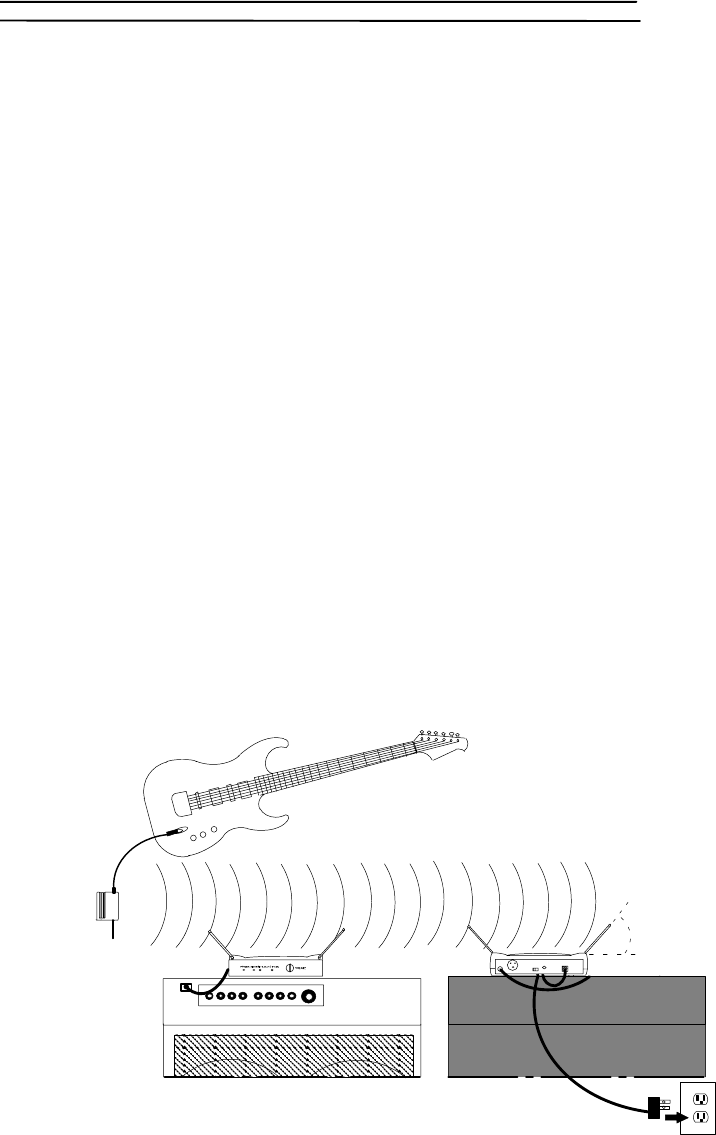
ENGLISH
OPERATING THE GUITARIST-UHF SYSTEM
1. Refer to Figure 11. Connect the supplied ac power adapter to the DC INPUT con-
nector in back of the receiver. Insert the adapter’s cable into the power cable retainer.
Plug the adapter into a wall socket or other ac power source (use PS20 for 120 Vac,
60 Hz power; use PS20E for 230 Vac, 50 Hz power). The green POWER light on
the receiver will glow.
2. Connect the receiver’s 1/4” PHONE JACK AUDIO OUTPUT connector to the am-
plifier input, using a standard guitar cable.
3. Connect your guitar or bass to the transmitter input jack with a WA302 Instrument
Adaptor. NOTE: The Guitarist-UHF system may also be used with woodwind and
brass instruments with use of an optional WM98 miniature instrument microphone
and a horn mount. See
Optional Accessories
for additional information.
4. Adjust the volume control on your guitar to desired level. To match wireless output
to that of a wired system, see
Receiver Volume Adjustment for the Guitarist.
5. Slide the transmitter’s POWER/OFF switch to the POWER position. The transmit-
ter’s POWER ON light and the receiver’s DIVERSITY A/B lights will glow.
6. Slide the transmitter MUTE/ON switch to the ON position.
7. Play your guitar or bass. Normal operation is indicated by:
•
Steady glow of receiver’s yellow DIVERSITY A/B lights.
•
Flickering of the receiver’s AUDIO PEAK light when loud sounds are transmitted
.
NOTE: If the red AUDIO PEAK light does not flicker occasionally or is on constantly,
the transmitter may need to be adjusted. Refer to the
Transmitter Audio Gain Adjust-
ment
section. If the system is still not operating properly, consult the
Troubleshooting
table.
8. When the performance is over, turn off the amplifier and slide the recessed trans-
mitter POWER/OFF switch to the OFF position to conserve battery power.
FIGURE 11
UT1
SHURE
SHURE
UT4
45°
FRONT BACK
12
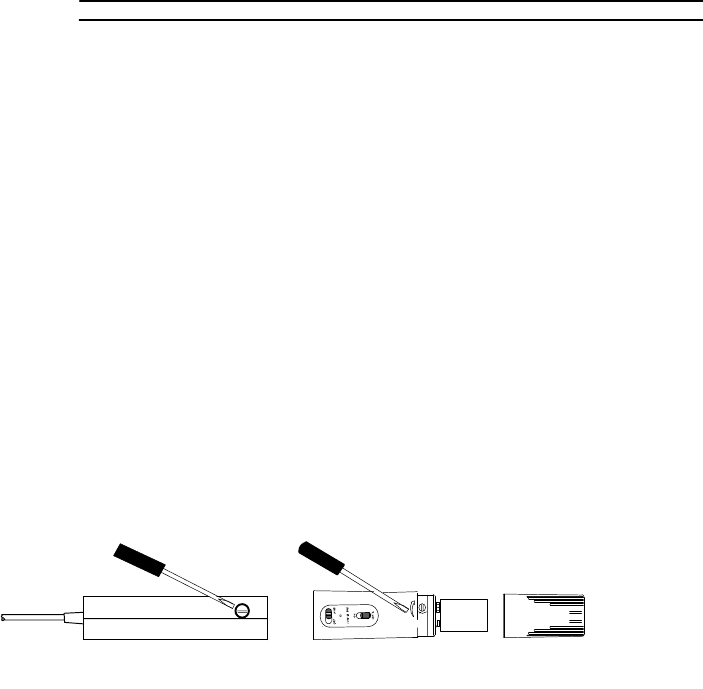
ENGLISH
RECEIVER VOLUME ADJUSTMENT FOR THE GUITARIST-UHF
Follow these directions to adjust the volume control of the UT4 receiver, so that the
wireless output of an instrument is equivalent to the output of a cabled instrument.
1. Plug instrument directly into guitar/bass amp. Set volume and tone controls on
both the instrument and amplifier for a clean signal with desired tonal quality and
volume. DO NOT change these settings for the rest of volume adjustment.
2. Unplug instrument from the amplifier input and plug into the transmitter. Plug the
receiver into amplifier input.
3. Set VOLUME control of receiver at 1/4 on (9:00). Play instrument, with enough
force to cause maximum output.
4. If there is distortion present, the transmitter may be clipping. See the
Transmitter
Audio Gain Adjustment
section
.
5. Adjust receiver volume control until sound quality matches that achieved in step 1.
TRANSMITTER AUDIO GAIN ADJUSTMENT
The audio gain control on both the UT1 body-pack and UT2 hand-held transmitters
has been factory-preset at the mid-range position for best performance in most ap-
plications. If the red AUDIO PEAK light on the receiver
does not
flicker, the preset gain
level may be too low and the audio gain may need to be increased until a proper signal-
to-noise ratio is reached. This may be necessary for soft singers or talkers, or guitar or
basses with low outputs.
For loud singers or talkers, or instruments with high outputs, the preset gain level
may be too high, causing unwanted distortion. This condition is indicated by the con-
tinuous glow of the red PEAK light on the receiver during usage.
FIGURE 12
+
-
UT1 BODY-PACK TRANSMITTER UT2 HAND-HELD TRANSMITTER
•
To Increase Gain:
Rotate the transmitter gain control clockwise with the supplied
screwdriver until the red AUDIO PEAK light on the receiver flickers when the gui-
tar is played loudly or when you sing or speak in a loud voice. NOTE: In some
applications, the red AUDIO PEAK light will not flicker even with the gain control
turned fully clockwise.
For body-pack systems only:
If gain control is rotated fully
clockwise and the AUDIO PEAK light still does not flicker, check to see if the in-
put attenuation switch on the transmitter is set to the –20 dB position. If it is, fully
rotate the gain control counterclockwise, and move the switch to the 0 dB posi-
tion. Then rotate the gain control clockwise until the AUDIO PEAK light flickers
during high output or the gain control is turned fully clockwise.
•
To Reduce Gain:
Rotate the transmitter gain control counterclockwise with the sup-
plied screwdriver. Continue rotating the gain control until the red AUDIO PEAK light
on the receiver only flickers when guitar is played loudly, or when you sing or
speak in a loud voice.
For body-pack systems only
: If gain control is rotated fully
counterclockwise and the AUDIO PEAK light still glows continuously, check to see if
the input attenuation switch on the transmitter is set to the 0 dB position. If it is, move
the switch to the –20 dB position, and fully rotate the gain control clockwise. Then
rotate the gain control counterclockwise until the AUDIO PEAK light flickers during
high output.
To return audio gain to the factory setting, rotate the transmitter audio gain control to the
mid position and, on the body-pack only, slide the input attenuation switch to the 0 dB
position.
13

ENGLISH
BODY-PACK AUDIO GAIN AND ATTENUATION SETTINGS
The attenuation switch and the gain control on the UT1 body-pack are designed to
be used in conjunction to provide a wide spectrum of gain control choices. The fol-
lowing ranges are starting points; actual output levels may vary.
OUTPUT DEVICE ATTENUATION
SWITCH SETTING
AUDIO GAIN
CONTROL SETTING
LAVALIER MICROPHONE, CONVERSATIONAL VOICE 0 dB HIGH (clockwise)
LAVALIER MICROPHONE, PROJECTED VOICE
HEADSET, CONVERSATIONAL VOICE 0 dB MID–RANGE
HEADSET, PROJECTED VOICE
ELECTRIC GUITAR/BASS, PASSIVE ELECTRONICS 0 dB LOW (counterclockwise)
ELECTRIC GUITAR/BASS, PASSIVE ELECTRONICS –20 dB HIGH (clockwise)
ELECTRIC GUITAR/BASS, ACTIVE ELECTRONICS –20 dB MID–RANGE
ELECTRIC GUITAR/BASS, ACTIVE ELECTRONICS –20 dB LOW (counterclockwise)
RECEIVER SQUELCH ADJUSTMENT
The squelch control on the UT4 receivers (see figure 1) is factory preset for op-
timum performance. No further adjustment is normally required. It is possible to
adjust the squelch control setting to emphasize either signal quality or system range:
•
Turning the squelch control clockwise causes the receiver to demand a higher
quality signal (less noise before muting), but
decreases
operating range.
•
Turning the squelch control counterclockwise allows a lower quality signal
through (more noise before muting), but
increases
operating range.
To return the receiver squelch control to the factory setting, rotate it to the mid-range
position (so the slot is vertical).
TIPS FOR ACHIEVING MAXIMUM PERFORMANCE
•
Make sure you can always see a receiver antenna from the transmitter position.
•
Keep the distance from transmitter to receiver antenna as short as possible.
•
Point receiver antennas away from each other at a 45
°
angle from vertical.
•
Avoid placing the receiver antennas near metal surfaces and obstructions.
•
To mount the receiver on a flat surface, attach the four adhesive rubber feet or
the VELCRO mounting strips to the bottom of the receiver.
•
Monitor battery fuel gauge and replace battery as soon as red light is on.
•
Let body-pack transmitter antenna hang freely; do not coil or keep in pocket.
•
If stacking or rack mounting receivers in a multiple-system use situation, do not
allow antennas to touch or cross.
•
Perform a walk-through before performance or presentation. If dead spots are
found, adjust location of receiver. If dead spots remain, mark spots and avoid.
TROUBLESHOOTING
PROBLEM INDICATOR STATUS SOLUTION
No sound. Green transmitter POWER
light off. Slide transmitter POWER ON/OFF switch to ON
position. Make sure battery is inserted properly, ob-
serving battery polarity (“+/–”). If battery is inserted
properly, replace with fresh battery.
No sound. Green transmitter POWER
light glowing. Slide transmitter MUTE/ON switch to ON position.
No sound. Green receiver POWER
light off. Make sure ac adapter is securely plugged into elec-
trical outlet and into dc input connector.
Make sure ac electrical outlet works and supplies
proper voltage.
No sound. Receiver DIVERSITY A/B
lights glowing. PEAK light
flickers during loud sounds.
Turn up receiver volume control.
Confirm that the output connections from the receiv-
er to the external equipment are secure.
14

ENGLISH
No sound. Receiver DIVERSITY A/B
lights off. Transmitter and
receiver POWER lights
glowing.
Confirm transmitter’s and receiver’s frequencies match.
Point receiver antennas away from each other at a 45°
angle from vertical.
Move receiver antennas away from any metal objects.
Remove obstructions between transmitter and receiver.
Make sure you can see receiver antennas.
Move transmitter closer to receiver.
Sound level differs
from level of a
cabled instrument.
Receiver DIVERSITY A/B
lights glowing. Adjust transmitter gain as necessary.
Adjust receiver volume as necessary.
Sound level differs
with different guitars. Receiver DIVERSITY A/B
lights glowing. Readjust transmitter gain level to compensate for dif-
ferences in guitar outputs.
Distortion level
increases gradually. Receiver DIVERSITY A/B
lights and transmitter LOW
BATTERY light glowing.
Replace transmitter battery.
Bursts of noise or
other audible radio
signals present.
DIVERSITY A/B lights on. Identify potential sources of interference (other rf
sources) and turn off, remove or use a wireless sys-
tem operating on a different frequency.
Momentary loss of
sound as transmitter
is moved around
performing area.
Receiver DIVERSITY A/B
lights off when sound is
lost.
Reposition receiver and perform walk-through test
again. If audio dropouts persist, mark “dead” spots
and avoid them during performance.
SYSTEM SPECIFICATIONS
RF Carrier Frequency Range
Approximately 596 to 862 MHz (Available frequencies depend on applicable regu-
lations in country where system is used).
Operating Range:100 m (approximately 300 ft) under typical conditions
Audio Frequency Response: 20 to 16,000 Hz, $3 dB
Image Rejection: 75 dB typical
Spurious Rejection: 75 dB typical
System Distortion (ref. 45 kHz deviation, 1 kHz modulation): 0.1% THD typical
Signal/Noise Ratio: 90 dB
Sensitivity: –110 dBm for 12 dB SINAD typical
Maximum Recommended Input Level, UT1 (attenuation switch at –20 dB, gain at
minimum): +32 dBV
Minimum Recommended Input Level, UT1 (attenuation switch at 0 dB, gain at
maximum): –80 dBV
Operating Temperature Range
–29° to 74° C (–20° to 165° F) NOTE: Battery characteristics may limit this range.
Battery Life
UT1, UT2: 12 hours with 9 V alkaline battery (Duracell MN1604 recommended).
UT1 BODY-PACK TRANSMITTER SPECIFICATIONS
RF Output 15 mW Typical
Input Configuration Unbalanced
Connector Type 4-pin Tini QG (male)
Actual Impedance 1 MΩ
Connector Pin
Assignments Pin 1:Tied to Ground
Pin 2:Tied to +5 V
Pin 3:Tied to Audio
Pin 4:Tied to 20kΩ Resistor and Audio Ground
Dimensions 82.6 mm H x 63.5 mm W x 26.2 mm D
(3.25” H x 2.50” W x 1.03” D)
Net Weight 125g (4.4 oz.) including battery
Power Requirements 9 V alkaline battery (Duracell MN1604 recommended);
9 V lithium ULTRALIFE battery optional.
Nominal Current
Drain 40 mA
15

ENGLISH
UT2 HAND-HELD TRANSMITTER SPECIFICATIONS
UT2/58 (SM58) UT2/31(BG3.1)
RF Output 15 mW Typical
Dimensions 241 mm H x 51 mm D
(9.49” H x 2.01” D) 225 mm H x 56 mm D
(8.86” H x 2.20” D)
Net Weight 296g (10.4 oz.) 218g (7.7 oz.)
Power Requirement 9 V alkaline battery (Duracell MN1604 recommended);
9 V lithium ULTRALIFE battery optional.
Nominal Current Drain 40 mA
UT4 RECEIVER SPECIFICATIONS
Connector 3-Pin XLR (male) 1/4” phone plug (female)
Maximum Output Levels Line Level: +10 dBV
Mic Level: –22 dBV +4 dBV
Nominal Output Levels Line Level: –26 dBV
Mic Level: –62 dBV –32 dBV
Output Configuration Active Balanced Unbalanced
Actual Impedance Line Level: 138 kΩ
Mic Level: 500 Ω 1 kΩ
Connector Pin
Assignments Pin 1: ground
Pin 2: hot
Pin 3: cold
Tip: hot
Sleeve: ground
Dimensions 41 mm H x 197 mm W x 138 mm D
(1.625” H x 7.77” W x 5.42” D)
Net Weight 419.6g (14.8 oz.)
Power Requirements 12–18 Vdc nominal, 200mA
Power Supply 120 V or 230V ac adaptor with 2.1 mm female plug
Voltage/Current/Phan-
tom Power Protection Yes Yes
CERTIFICATION
UT1: Type Accepted under FCC Part 74. Certified by IC in Canada under
RSS–123. Conforms to European Union directives, eligible to bear CE marking;
meets European Union Requirements. ETSI Type Approval: pr I–ETS 300 422,
EMC Immunity: ETS 300 445.
UT2/31, UT2/58: Type Accepted under FCC Part 74. Certified by IC in Canada under
RSS–123. Conforms to European Union directives, eligible to bear CE marking;
meets European Union Requirements. ETSI Type Approval: pr I–ETS 300 442,
EMC Immunity: ETS 300 445.
UT4: Approved under the Notification provision of FCC Part 15. Certified by IC in Cana-
da under RSS–123. Conforms to European Union directives, eligible to bear CE
marking; meets European Union Requirements. EMC Immunity: ETS 300 445.
Power supply meets Low Voltage Directive: 73/23/EEC.
FURNISHED ACCESSORIES
Screwdriver 65A1659. . . . . . . . . . . . . . . . . . . . . . . . . . . . . . . . . . . . . . . . . . . . . . . . . .
Mounting Block (The Presenter Systems Only) RK329MB*. . . . . . . . . . . . . . . . . .
Single-Mount Tie Bar (The Presenter Systems Only) RK240SB*. . . . . . . . . . . . .
Windscreen (The Presenter Systems Only) RK242WS*. . . . . . . . . . . . . . . . . . . . .
Receiver AC Adapter PS20 (120V), PS20E (230V). . . . . . . . . . . . . . . . . . . . . . . . .
Vinyl Transmitter Bag (Body-Pack Systems Only) 26A13. . . . . . . . . . . . . . . . . . . .
Vinyl Transmitter Bag (The Vocal Artist Systems Only) 26A14. . . . . . . . . . . . . . . .
Swivel Adapter (The Vocal Artist Systems Only) WA370A. . . . . . . . . . . . . . . . . . .
∗ Replacements furnished in multiples of 4.
16

ENGLISH
OPTIONAL ACCESSORIES
1/4” to 1/4” Cable (The Guitarist-UHF only) WA303. . . . . . . . . . . . . . . . . . . . . . . . .
1/4” to Tini QG Cable WA302. . . . . . . . . . . . . . . . . . . . . . . . . . . . . . . . . . . . . . . . . . .
1.8 Meter (6 ft.) Receiver-Mixer Cable WA410. . . . . . . . . . . . . . . . . . . . . . . . . . . . .
Rack Mount Tray URT. . . . . . . . . . . . . . . . . . . . . . . . . . . . . . . . . . . . . . . . . . . . . . . . . .
Nylon Carrying Case WA590. . . . . . . . . . . . . . . . . . . . . . . . . . . . . . . . . . . . . . . . . . . .
Dual Tie Clip (The Presenter-UHF w/WL184, WL185 only) RK183T2. . . . . . . . .
Double Tie Clip (The Presenter-UHF w/WL93 only) RK307DB. . . . . . . . . . . . . . . .
Miniature Instrument Microphone (Body-Pack Systems only) WM98. . . . . . . . . .
Universal Horn Clamp (Body-Pack Systems only) A98KCS. . . . . . . . . . . . . . . . . .
Miniature Instrument Microphone w/ Universal Horn Clamp WM98KCS. . . . . . . .
Rubber Receiver Feet (4) 66A8053. . . . . . . . . . . . . . . . . . . . . . . . . . . . . . . . . . . . . . .
VELCRO Fastener, Hook (2) 80A8118. . . . . . . . . . . . . . . . . . . . . . . . . . . . . . . . . . . .
VELCRO Fastener, Loop (2) 80A8119. . . . . . . . . . . . . . . . . . . . . . . . . . . . . . . . . . . .
Amp/Powered Mixer Stand for UT4 Receiver WA595. . . . . . . . . . . . . . . . . . . . . . . . .
Inline Audio Switch for UT1 Transmitter WA360. . . . . . . . . . . . . . . . . . . . . . . . . . . .
For additional service or parts information, contact Shure’s Service department at
1–800–516–2525. Outside the U.S., contact an Authorized Shure Service Center.
VELCRO is a registered trademark of Velcro Industries B.V.
LICENSING INFORMATION
IMPORTANT: Licensing of Shure wireless microphone equipment is the user’s re-
sponsibility, and licensability depends on the user’s classification and applica-
tion, and on the selected frequency. Shure strongly urges the user to contact the ap-
propriate telecommunications authority concerning proper licensing, and before
choosing and ordering frequencies. Changes or modifications not expressly ap-
proved by Shure Incorporated could void your authority to operate the equipment.
Operation of this equipment is subject to the following two conditions: (1) this device
may not cause interference and (2) this device must accept interference, including
interference that may cause undesired operation of the device.
WARRANTY INFORMATION
Shure Incorporated (“Shure”) hereby warrants that these products are free from de-
fects in material and workmanship for a period of two years from the date of purchase
for all microphone cartridge and housing assembly parts and, for a period of one year
from date of purchase, all transmitter and receiver parts. At its option, Shure will re-
pair or replace the defective product and promptly return it to you. You should retain
proof of purchase to validate the purchase date and return it with any warranty claim.
If you believe this product is defective within the warranty period, carefully repack the
unit, insure it, and return it postpaid to:
Shure Incorporated
Attention: Service Department
222 Hartrey Avenue
Evanston, IL 60202-5730 U.S.A.
Customers outside the U.S.A. should ship the product to the authorized Shure Dis-
tribution Center in their region.
This warranty does not apply in cases of abuse or misuse of the product, use con-
trary to Shure’s instruction, or unauthorized repair. All implied WARRANTIES of
MERCHANTABILITY or FITNESS FOR A PARTICULAR PURPOSE are hereby dis-
claimed and Shure hereby disclaims liability for incidental, special or consequential
damages resulting from use or unavailability of this product.
Some states do not allow limitations on how long an implied warranty lasts, or the
exclusion or limitation of incidental or consequential damages, so the above limita-
tion may not apply to you. This warranty gives you specific legal rights, and you may
have other rights which vary from state to state.
THIS WARRANTY SUPERSEDES ALL WARRANTIES THAT ARE INCLUDED WITH
THIS PRODUCT.
17
